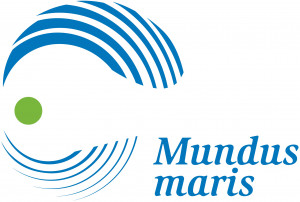Act on lifestyles and sustainable being, reform policies and incentives, make education for sustainability cool and manage land and water resources in ways compatible with the regenerative capacities of mother Earth! Recommendations of students clustered around these four thrusts after intensive conversations.
Sixty seven students had followed the invitation to the Student Conference “Feeding the World without Destroying the World: Can Food Production Be(come) Sustainable?” in Rogow, Poland, from 15 to 19 April 2015. They are pursuing their studies at the universities, which are part of the Regional University Network called the Baltic University.
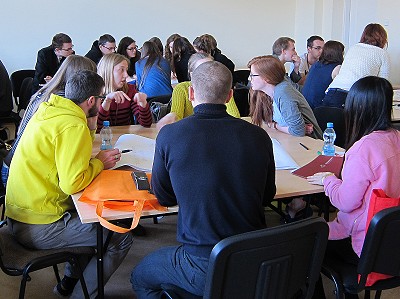
Prof. Alexander Feher of the Slowak University of Agriculture in Nitra introduced the study programme of the second day. In four impulse talks on sustainable food production and food security lecturers provided inputs about different angles to the challenge.
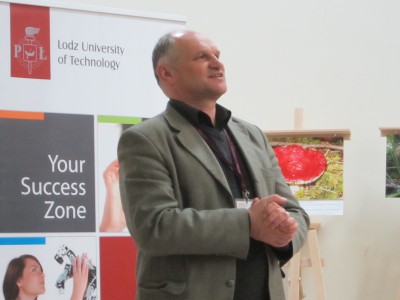
Dr. Sylvia Lorek of Sustainable Europe Research Institute (SERI) and the University of Applied Science in Munster, Germany spoke about consumers and sustainable consumption. Instead of giving a conventional lecture, she put emphasis on interaction with the students on key questions to solicit their own reflections and experiences.
She had asked the students to keep food diaries in the week prior to meeting up at the conference. Turning to these right from the start, a mix of similar foods and others came up.
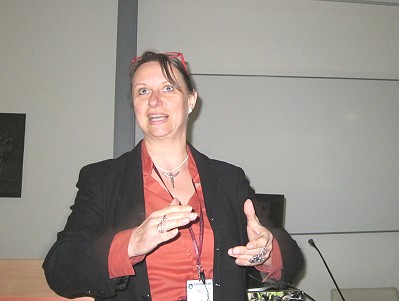
Interestingly, while the global food system showed through some of the similarities, the students reported a fair part of regional specialties indicative of cultural and historical variety.
The question on what the students considered as sustainable food produced a long list of criteria including
- only as many calories as required for an active life
- reducing waste
- origin of food (as local as possible)
- least processed
- price (best within budget also for economically disadvantaged people)
- reduce soft drinks and fast food
- food produced in eco-friendly ways (low energy, low CO2…)
- food from fair trade and peaceful situations
- seasonal food
- less animal products (meat, dairy)
- reduced packaging
She challenged the students to think about what might happen in case of a failure in the sophisticated supply chains for food, e.g. when electricity shortages might affect fresh and frozen food and the growing offer of ready meals.
The responses were quite diverse. In groups of fours – usually from different countries – the students came up with a range of responses as to how to overcome such a crisis. Some with roots in rural areas or with family gardens hoped to fall back on a larger percentage of self-production. Others without such resources were skeptical that alternatives would be accessible quickly enough to avoid conflict or major hardship before adjustments would at least help to meet basic needs.
The sustainable food debate then also touched on other aspects, which may look less dramatic at first glance, but have huge repercussions on how humans change the planet. Few people realise that the industrial food production system and its international trade and distribution system account for almost 50% of CO2 emissions and associated climate change. The material and energy inputs are just enormous. “Worst offenders” in terms of the carbon and water foot prints are beef, butter, cheese and other dairy products.
Lots of food for thought.
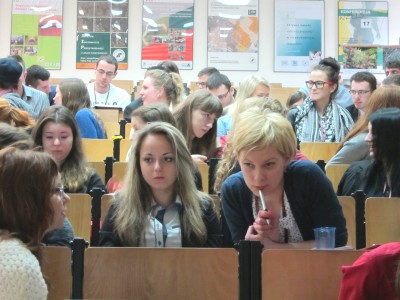
Two students from the Research Institute for Physical and Chemical Problems of Belarusian State University, Lizaveta Gotina and Sviatlana Kavaliok, gave an animated talk complete with experiments and samples that addressed the question “Edible packaging films – a helpful eco-friendly idea or the next BIG food product? It may be premature to give a definitive answer. Edible packaging films are not intended to replace non-edible outer packaging, but they could well play a greater role in reducing wastage in portioned and delicate food stuffs.
In his talk about the “landscape and food production – biodiversity” Prof. Feher gave ample examples about how humans are shaping their environment to the needs of their production and consumption system. Large-scale monoculture may make impressive photos of sunflowers or other industrial crops reaching to the horizon, Prof. Feher cautioned that these were not viable in the long run. Underneath the monotony, nature often shows profound traces of its history, e.g. in old meanders of rivers that can be traced in aereal photos.
Growing globalisation was moreover transporting previously separated species of plants and animals across natural boundaries. Such newcomers may become invasive species, if they have no natural predators or diseases to keep them in check. Their expansion may happen at the expense of native species until a new equilibrium is established. Though introductions of alien species do not automatically lead to invasiveness, they often lead to large economic and ecological costs.
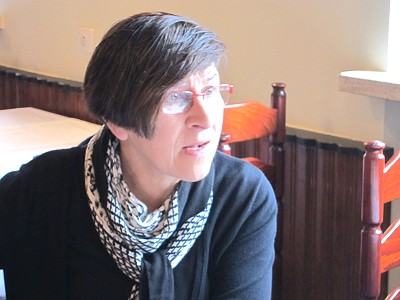
Prof. Lubos Jurik, also of the Slovak University of Agriculture in Nitra, added perspectives on soil and water to the discussion how food production shaped landscapes. His take-home message centered on the need to care for soils and water as essential resources for our survival. In numerous examples selected from his varied international career as an environmental engineer and academic he made his points in a particularly lively manner.
Dr. Cornelia E Nauen of Mundus maris spoke to the topic of food security and the sea.
She filled in some basics about the Baltic embedded in the global landscape and the interconnectedness of the land and the ocean.
She illustrated the four major threats to sustainable marine food and the essential role of the ocean for life on earth:
- Illegal, unreported and unregulated (IUU) fishing as a major expression of the global fisheries crisis driven by weak governance and harmful subsidies,
- climate change with sealevel rise, acidification and poleward migration of fish and other marine life unable to live in warming waters with less oxygen,
- the global crisis of marine litter with its death toll of choked and starved birds, turtles, marine mammals and fish; and plastics coming back to haunt humans as top predators,
- growing inequality in many societies which correlates directly with many social and health and public problems and wastage.
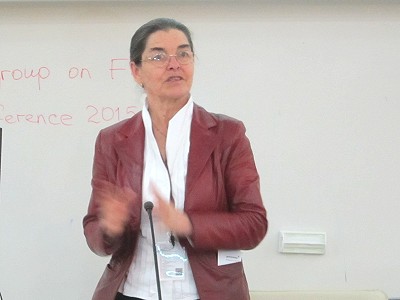
Far from giving up in the face of such worrysome diagnostics, she summarised the eight practical proposals pub forward last year by the Global Ocean Commission as a rescue package for the global ocean to turn decline around into recovery.
They are:
- A UN Sustainable Development Goal for the Ocean – Putting a healthy living ocean at the heart of development – is already on the way of being achieved as can be seen from the draft prepared for the UN General Assembly in September 2015 scheduled to adopt the post 2015 SDGs.
- Governing the High Seas – Promoting care and recovery.
- No More Overfishing – Ending harmful high seas subsidies – that is also the challenge for implementing the reform of the European Common Fisheries Policy adopted in 2013/14.
- Illegal, Unreported and Unregulated Fishing – Closing seas, ports and markets.
- Plastics – Keeping them out of the ocean.
- Offshore Oil and Gas – Establishing binding international safety standards and liability.
- Global Ocean Accountability Board – Monitoring progress toward a healthy ocean.
- Creating a High Seas Regeneration Zone.
It may not be easy but it can and must be done. Not only the fish, but also the three billion people depending for their livelihood on the ocean will be winners.
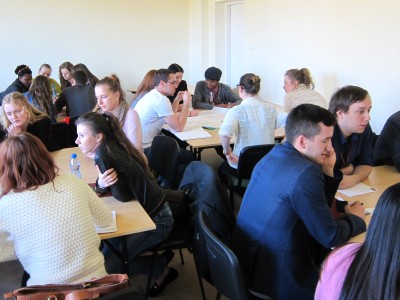
After so many inputs and exchanges, it was time for an even more interactive workshop. The hosting team of previous speakers invited the students to a world café style conversation about the key question of the conferenceL Can food production be(come) sustainable?
In three rounds of intensive listening and conversation the students came up with lots of interesting ideas which clustered under the headlines: Act on lifestyles and sustainable being, reform policies and incentives, make education for sustainability cool and manage land and water resources in ways compatible with the regenerative capacities of mother Earth!
The conference programme continued with visits and more lectures and exchanges focused on regional perspectives. In times of growing political tensions the seamlessly friendly and cooperative tone of exchanges between these young leaders of tomorrow augures well for the next 25 years of the Baltic University.
Photos by Cornelia E Nauen. Click here for more info on the Baltic University Programme.
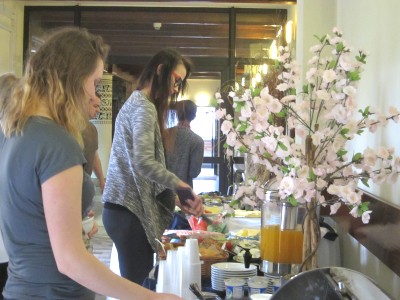
Il mare ci nutre
- World Food Day 2024, Joint Webinar with Fish Party
- Relatore Speciale delle Nazioni Unite sul diritto al cibo
- EP Hearing on EU Citizen Initiative to stop shark finning
- Keynote at the ‘Feed the Future – Innovation Lab for Fish’
- FAO webinar ‘Pesce piccolo a basso prezzo: dall’esca al piatto’, 15-16/02/2021
- Pesce e frutti di mare deliziosi e sostenibili ai workshop di Mundus maris
- Chiloé, ossia: il disastro di Salmonopoli
- Seafood Symposium – Dalla pesca ai buongustai, 27 Aprile 2015
- Baltic students concerned about sustainable foods, Rogow, Poland, 15-19 April 2015
- Dai piatti al carburante – il controverso boom delle alghe in Cile
- Khazan – Traditional coastal zone management in Goa, India
- Comportamento del consumatori attento all’ambiente nel settore alimentare: cosa posso fare?
- Save baby fish or Point ‘n’ kill?
- “Inseparable” – La campagna sulla sostenibilità del pesce celebra un evento ad Atene
- Respect for minimum fish size. What do Senegalese fish mongers have to say?
- La campagna di Mundus maris nei mercati di Dakar
- Salviamo gli Oceani! – Cercle Europa esorta
- International Study Group Brussels: Save the Seas!
- Mercado San Miguel in Central Madrid
